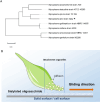Unraveling the role of distinct cytoskeletal motility structures in Mycoplasma pneumoniae relatives
- PMID: 40883708
- PMCID: PMC12395765
- DOI: 10.1186/s12866-025-04320-w
Unraveling the role of distinct cytoskeletal motility structures in Mycoplasma pneumoniae relatives
Abstract
Mycoplasma represents a unique genus of prokaryotic bacteria distinguished by the absence of a cell wall, a characteristic that sets it apart from other bacteria. Within the Mollicutes class, phylogenetic analysis reveals three distinct categories: Spiroplasma, Mycoplasma and Acholeplasma. Mycoplasmas within Pneumoniae are recognized for their capacity to induce a range of diseases in both humans and animals, frequently impacting respiratory and reproductive health. The representative strains in Pneumoniae group, particularly the M. pneumoniae clusters, have garnered significant attention due to their remarkable ability to adhere to, invade, and traverse host cells. This ability is facilitated by specialized structures known as attachment organelles, which possess a unique cytoskeletal structure that supports a distinctive gliding motility mechanism. This mode of motility is distinct from that observed in eukaryotes and the majority of bacteria. The gliding machinery of Mycoplasma is a complex assembly consisting of both surface and internal components, including a terminal button, paired plates, and a structure resembling a bowl or wheel. The internal architecture of the attachment organelles provides the essential scaffold for the operation of this sophisticated motility system. Mycoplasma's gliding motility is crucial for its infection process and its capacity to evade the host immune defenses. Understanding the role of this motility to immune evasion can offer profound insights into the pathogenesis of these bacteria, could pave the way for the development of more effective therapeutic strategies against diseases caused by Mycoplasma and related species.
Keywords: Mycoplasma; Mycoplasma pneumoniae relatives; Cytoadherence; Cytoskeleton; Motility; Pathogenesis.
© 2025. The Author(s).
Conflict of interest statement
Declarations. Ethics approval and consent to participate: Not applicable. Consent for publication: Not applicable. Competing interests: The authors declare no competing interests.
Figures



Similar articles
-
Prescription of Controlled Substances: Benefits and Risks.2025 Jul 6. In: StatPearls [Internet]. Treasure Island (FL): StatPearls Publishing; 2025 Jan–. 2025 Jul 6. In: StatPearls [Internet]. Treasure Island (FL): StatPearls Publishing; 2025 Jan–. PMID: 30726003 Free Books & Documents.
-
Systematic analysis of structural disorder in the minimal proteome of Mycoplasma pneumoniae.Microbiol Spectr. 2025 Aug 5;13(8):e0096825. doi: 10.1128/spectrum.00968-25. Epub 2025 Jun 18. Microbiol Spectr. 2025. PMID: 40530859 Free PMC article.
-
Short-Term Memory Impairment.2024 Jun 8. In: StatPearls [Internet]. Treasure Island (FL): StatPearls Publishing; 2025 Jan–. 2024 Jun 8. In: StatPearls [Internet]. Treasure Island (FL): StatPearls Publishing; 2025 Jan–. PMID: 31424720 Free Books & Documents.
-
Management of urinary stones by experts in stone disease (ESD 2025).Arch Ital Urol Androl. 2025 Jun 30;97(2):14085. doi: 10.4081/aiua.2025.14085. Epub 2025 Jun 30. Arch Ital Urol Androl. 2025. PMID: 40583613 Review.
-
Immunogenicity and seroefficacy of pneumococcal conjugate vaccines: a systematic review and network meta-analysis.Health Technol Assess. 2024 Jul;28(34):1-109. doi: 10.3310/YWHA3079. Health Technol Assess. 2024. PMID: 39046101 Free PMC article.
References
-
- Chernova OA, Chernov VM, Mouzykantov AA, Baranova NB, Edelstein IA, Aminov RI. Antimicrobial drug resistance mechanisms among Mollicutes. Int J Antimicrob Agents. 2021;57(2):106253. - PubMed
-
- Trachtenberg S, Mollicutes. Curr Biol. 2005;15(13):R483–4. - PubMed
-
- You Y, Xiao J, Chen J, Li Y, Li R, Zhang S, et al. Integrated information for pathogenicity and treatment of Spiroplasma. Curr Microbiol. 2024;81(8):252. - PubMed
Publication types
MeSH terms
Grants and funding
- S202310555204/The Hunan Provincial College Students' Innovation and Entrepreneurship Training Program
- 2021SK50401/Hunan Province Science and Technology Innovation Plant Project
- 2025JJ60918/Natural Science Foundation of Hunan Province, China
- 21B0435/The Scientific Research Foundation of Hunan Provincial Education Department, China
LinkOut - more resources
Full Text Sources

